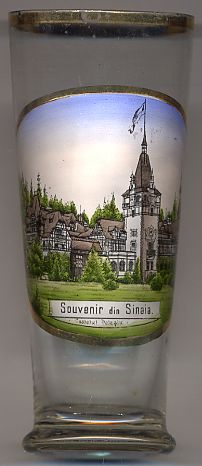

|
| ROMÂNIA | ROMANIA |
| județ Prahova | Prahova County |
 Sinaia is situated at an elevation of 767 m in a mountainous area on the Prahova River valley, just east of the Bucegi Mountains,
about 60 km northwest of Ploiești, the administrative seat of Prahova County. The town has a population of about 12,000 (2007) and is one of
Romania's popular mountain resorts. The town was named after Sinaia Monastery, around which it was built; the monastery in turn is named after the Biblical Mount Sinai.
Sinaia is situated at an elevation of 767 m in a mountainous area on the Prahova River valley, just east of the Bucegi Mountains,
about 60 km northwest of Ploiești, the administrative seat of Prahova County. The town has a population of about 12,000 (2007) and is one of
Romania's popular mountain resorts. The town was named after Sinaia Monastery, around which it was built; the monastery in turn is named after the Biblical Mount Sinai.
 Peleș castle [left] was built in 1873–1883 for King Carol I of Romania (Karl Eitel Friedrich von Hohenzollern-Sigmaringen),
the first king of Romania. The plans were drawn by the Vienna architect was Carl Wilhelm Christian von Doderer. After 1876 the construction works were
supervised by Doderer's assistant, Johannes Schultz, who modified the original plans. The official inauguration of the castle took place on 7 October 1883.
The Czech architect Karel Liman was in charge of furter constructions which were added between 1893 and 1914 and included the characteristic main tower.
The style of the castle is reminiscent of the Austro-Hungarian period — although Sinaia itself never was part of the Austrian Empire — as well as
of Hohenzollern Castle, the birthplace of the king. The castle has 160 rooms, part of which are now open to the public.
Until Carol's death in 1914 the castle served as his summer residence. In 1947 the Communist regime confiscated the castle.
Peleș castle [left] was built in 1873–1883 for King Carol I of Romania (Karl Eitel Friedrich von Hohenzollern-Sigmaringen),
the first king of Romania. The plans were drawn by the Vienna architect was Carl Wilhelm Christian von Doderer. After 1876 the construction works were
supervised by Doderer's assistant, Johannes Schultz, who modified the original plans. The official inauguration of the castle took place on 7 October 1883.
The Czech architect Karel Liman was in charge of furter constructions which were added between 1893 and 1914 and included the characteristic main tower.
The style of the castle is reminiscent of the Austro-Hungarian period — although Sinaia itself never was part of the Austrian Empire — as well as
of Hohenzollern Castle, the birthplace of the king. The castle has 160 rooms, part of which are now open to the public.
Until Carol's death in 1914 the castle served as his summer residence. In 1947 the Communist regime confiscated the castle.
![[scale]](lineal.jpg)